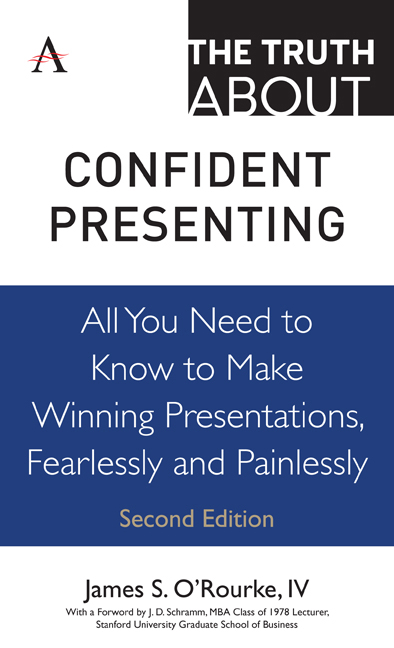 The Truth about Confident Presenting
The Truth about Confident Presenting Book contents
- Frontmatter
- Contents
- Foreword
- Introduction
- Part I Some Initial Truths
- Part II The Truth About Getting Ready to Speak
- Part III The Truth About What Makes People Listen
- Part IV The Truth About Developing Support for Your Presentation
- Truth 19 Develop support for your presentation
- Truth 20 Understand the power of your content
- Truth 21 The kinds and quality of evidence matter to your audience
- Truth 22 Structure can help carry an inexperienced speaker
- Truth 23 Find support for your presentation
- Truth 24 Use the Internet to support your presentation
- Part V The Truth About Getting Up to Speak
- Part VI The Truth About Managing Anxiety
- Part VII The Truth About Nonverbal Communication
- Part VIII The Truth About Visual Aids
- Part IX The Truth About Handling an Audience
- Part X The Truth About What Makes a Presentation Work
- References
- Acknowledgments
- About the Author
Truth 22 - Structure can help carry an inexperienced speaker
from Part IV - The Truth About Developing Support for Your Presentation
- Frontmatter
- Contents
- Foreword
- Introduction
- Part I Some Initial Truths
- Part II The Truth About Getting Ready to Speak
- Part III The Truth About What Makes People Listen
- Part IV The Truth About Developing Support for Your Presentation
- Truth 19 Develop support for your presentation
- Truth 20 Understand the power of your content
- Truth 21 The kinds and quality of evidence matter to your audience
- Truth 22 Structure can help carry an inexperienced speaker
- Truth 23 Find support for your presentation
- Truth 24 Use the Internet to support your presentation
- Part V The Truth About Getting Up to Speak
- Part VI The Truth About Managing Anxiety
- Part VII The Truth About Nonverbal Communication
- Part VIII The Truth About Visual Aids
- Part IX The Truth About Handling an Audience
- Part X The Truth About What Makes a Presentation Work
- References
- Acknowledgments
- About the Author
Summary
Some years ago a college professor took a well-organized speech and scrambled it by randomly changing the order of its sentences. He then had a speaker deliver the original version to one group of listeners and the scrambled version to another group. After the speeches, he gave a test to see how well each group understood what they had heard. Not surprisingly, the group that heard the original, unscrambled presentation scored much higher than the other group.
A few years later, two professors repeated the same experiment at another school. But instead of testing how well the listeners understood each speech, they tested to see what effects the speeches had on the listeners’ attitudes toward the speakers. They found that people who heard the well-organized speech believed the speaker to be much more competent and trustworthy than did those who heard the scrambled speech. These are just two of many studies which have shown the value of organization and structure in a presentation or speech. You undoubtedly know from personal experience that you appreciate and learn more from hearing a well-organized talk compared to one that's poorly organized or contains no internal structure.
Organization is important for two other reasons, as well. First, structure is closely connected to critical thinking. When you try to organize your presentation, you gain practice in the general skill of establishing clear relationships among your ideas. Evidence also suggests that using a clear, specific method of organization can boost your confidence as a speaker and improve your ability to deliver a message fluently.
The second, and equally important reason for organizing a presentation is that you'll save your audience the trouble of doing it for you. If you make them work at listening to and organizing your thoughts, evidence and reasoning, they won't like it. Some, as you've seen, are highly motivated to learn what you're saying and will do the work necessary to make sense of it. Others won't even try and will just give up.
Presenters benefit from organizing a presentation, too. A message 22 that unfolds as an orderly sequence of points is easier to remember, and therefore, takes less time to rehearse. As a result, the presentation itself is easy to give.
- Type
- Chapter
- Information
- The Truth about Confident PresentingAll You Need To Know To Make Winning Presentations, Fearlessly And Painlessly, pp. 85 - 88Publisher: Anthem PressPrint publication year: 2019
